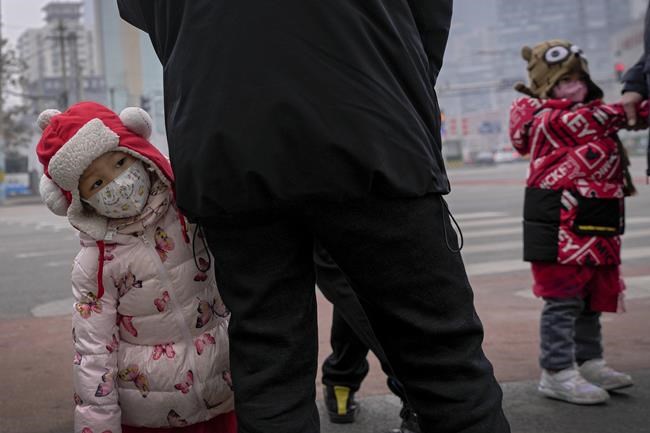Omicron allows outlook of hope
Read this article for free:
or
Already have an account? Log in here »
To continue reading, please subscribe:
Monthly Digital Subscription
$0 for the first 4 weeks*
- Enjoy unlimited reading on winnipegfreepress.com
- Read the E-Edition, our digital replica newspaper
- Access News Break, our award-winning app
- Play interactive puzzles
*No charge for 4 weeks then price increases to the regular rate of $19.00 plus GST every four weeks. Offer available to new and qualified returning subscribers only. Cancel any time.
Monthly Digital Subscription
$4.75/week*
- Enjoy unlimited reading on winnipegfreepress.com
- Read the E-Edition, our digital replica newspaper
- Access News Break, our award-winning app
- Play interactive puzzles
*Billed as $19 plus GST every four weeks. Cancel any time.
To continue reading, please subscribe:
Add Free Press access to your Brandon Sun subscription for only an additional
$1 for the first 4 weeks*
*Your next subscription payment will increase by $1.00 and you will be charged $16.99 plus GST for four weeks. After four weeks, your payment will increase to $23.99 plus GST every four weeks.
Read unlimited articles for free today:
or
Already have an account? Log in here »
Hey there, time traveller!
This article was published 25/01/2022 (1413 days ago), so information in it may no longer be current.
Predicting the end of the COVID-19 pandemic is a fool’s game. Many have tried, all have failed — particularly impatient politicians who have prematurely declared victory against the coronavirus, only to see their hospitals filled with COVID-19 patients again.
That does not mean the pandemic tunnel is dark. There is light at the end of it. It’s just difficult to gauge the speed at which it’s approaching.
Hope seen once the omicron wave increases global immunity

Posted:
World health officials are offering hope that the ebbing of the omicron wave could give way to a new, more manageable phase of the COVID-19 pandemic, even as they warn of difficult weeks ahead and the possibility of another, more dangerous variant arising.
Dr. Hans Kluge, the World Health Organization’s regional director in Europe, offered a sensible and hopeful message Monday: he said he believes the world can end the “emergency phase” of the pandemic in 2022 and that the Omicron variant “offers plausible hope for stabilization and normalization.”
It’s a realistic outlook. The world is not in the same place it was two years ago when COVID-19 began spreading rapidly around the globe. We are not even in the same place we were last spring when the Delta variant caused severe and widespread illness among largely unvaccinated populations.
Today, the vast majority of Manitobans and Canadians have had at least two doses of the COVID-19 vaccine, which continues to provide strong protection against severe illness and death. The vaccine does not prevent infection against Omicron the way it did with previous strains. But the data show hospitalization and death rates remain far higher among the unvaccinated than those with at least two doses. People with three doses are even better protected.
That is not an excuse to become complacent. Even though Omicron causes milder symptoms for most people compared with previous strains, the variant is so transmissible, the sheer number of infections it causes is driving up hospital admissions.
Nevertheless, society and the medical community have tools and knowledge they did not have two years ago. Used wisely and distributed equitably throughout the world, it is those resources that represent the light at the end of the tunnel, Dr. Kluge said.
“Although Omicron offers plausible hope for stabilization and normalization, our work is not done,” Dr. Kluge wrote. “Huge disparities in access to vaccines remain. If 2021 was the year of vaccine production, 2022 must be the year of vaccine equity in the European Region and beyond.”

The COVID-19 pandemic will end, like previous ones did, he said. More variants will likely emerge. But with new tools and knowledge, there’s good reason to believe the virus can be managed with far less illness and societal disruption, said Dr. Kluge.
“With strong surveillance and monitoring of new variants, high vaccination uptake and third doses, ventilation, affordable equitable access to antivirals, targeted testing, and shielding high-risk groups with high-quality masks and physical distancing if and when a new variant appears, I believe that a new wave could no longer require the return to pandemic-era, population-wide lockdowns or similar measures,” he wrote.
It is a persuasive argument, one that is based on science and reasonable assumptions. Political will at the global level will be required to ensure equitable access to vaccines and antivirals in less affluent countries. If that will is strong enough, a return to normalcy is achievable in the near future, thanks in large part to advances in science.
No one can predict when the pandemic will end. However, Dr. Kluge’s assessment of the current state of affairs offers a healthy dose of hope and a realistic path to a post-pandemic world.






